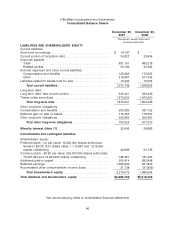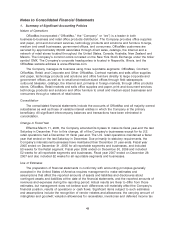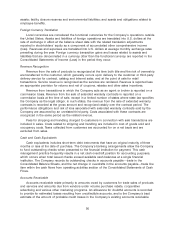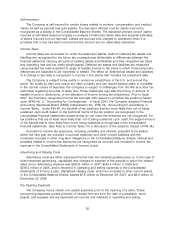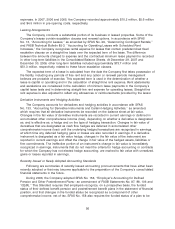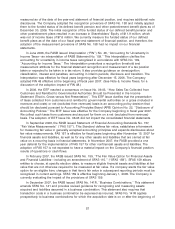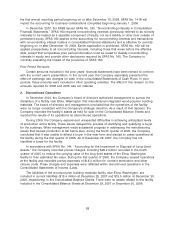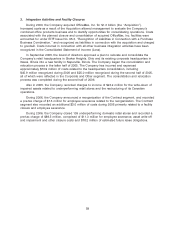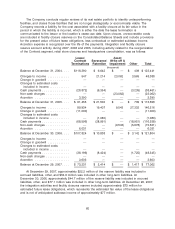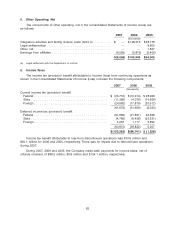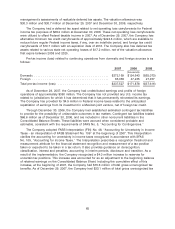OfficeMax 2007 Annual Report Download - page 60
Download and view the complete annual report
Please find page 60 of the 2007 OfficeMax annual report below. You can navigate through the pages in the report by either clicking on the pages listed below, or by using the keyword search tool below to find specific information within the annual report.expenses. In 2007, 2006 and 2005, the Company recorded approximately $10.2 million, $5.6 million
and $4.5 million in pre-opening costs, respectively.
Leasing Arrangements
The Company conducts a substantial portion of its business in leased properties. Some of the
Company’s leases contain escalation clauses and renewal options. In accordance with SFAS
No. 13, ‘‘Accounting for Leases,’’ as amended by SFAS No. 29, ‘‘Determining Contingent Rentals,’’
and FASB Technical Bulletin 85-3, ‘‘Accounting for Operating Leases with Scheduled Rent
Increases,’’ the Company recognizes rental expense for leases that contain predetermined fixed
escalation clauses on a straight-line basis over the expected term of the lease. The difference
between the amounts charged to expense and the contractual minimum lease payment is recorded
in other long-term liabilities in the Consolidated Balance Sheets. At December 29, 2007 and
December 30, 2006, other long-term liabilities included approximately $73.7 million and
$51.3 million, respectively, related to these future escalation clauses.
The expected term of a lease is calculated from the date the Company first takes possession of
the facility, including any periods of free rent and any option or renewal periods management
believes are probable of exercise. This expected term is used in the determination of whether a
lease is capital or operating and in the calculation of straight-line rent expense. Rent abatements
and escalations are considered in the calculation of minimum lease payments in the Company’s
capital lease tests and in determining straight-line rent expense for operating leases. Straight-line
rent expense is also adjusted to reflect any allowances or reimbursements provided by the lessor.
Derivative Instruments and Hedging Activities
The Company accounts for derivatives and hedging activities in accordance with SFAS
No. 133, ‘‘Accounting for Derivative Instruments and Certain Hedging Activities,’’ as amended,
which requires that all derivative instruments be recorded on the balance sheet at fair value.
Changes in the fair value of derivative instruments are recorded in current earnings or deferred in
accumulated other comprehensive income (loss), depending on whether a derivative is designated
as, and is effective as, a hedge and on the type of hedging transaction. Changes in fair value of
derivatives that are designated as cash flow hedges are deferred in accumulated other
comprehensive income (loss) until the underlying hedged transactions are recognized in earnings,
at which time any deferred hedging gains or losses are also recorded in earnings. If a derivative
instrument is designated as a fair value hedge, changes in the fair value of the instrument are
reported in current earnings and offset the change in fair value of the hedged assets, liabilities or
firm commitments. The ineffective portion of an instrument’s change in fair value is immediately
recognized in earnings. Instruments that do not meet the criteria for hedge accounting or contracts
for which the Company has not elected hedge accounting, are marked to fair value with unrealized,
gains or losses reported in earnings.
Recently Issued or Newly Adopted Accounting Standards
Following are summaries of recently issued accounting pronouncements that have either been
recently adopted or that may become applicable to the preparation of the Company’s consolidated
financial statements in the future.
During 2006, the Company adopted SFAS No. 158, ‘‘Employer’s Accounting for Defined
Pension and Other Postretirement Plans—an amendment of FASB Statements No. 87, 88, 106 and
132(R).’’ This Standard requires that employers recognize, on a prospective basis, the funded
status of their defined benefit pension and postretirement benefit plans in the statement of financial
position, and that changes in the funded status be recognized as a component of other
comprehensive income, net of tax. SFAS No. 158 also requires the funded status of a plan to be
56


